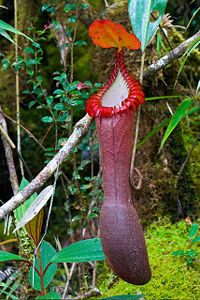Nepenthes
| Nepenthes | |
|---|---|

| |
| Upper pitcher of Nepenthes edwardsiana | |
| Scientific classification | |
| Kingdom: | |
| Division: | |
| Class: | |
| Order: | |
| Family: | Nepenthaceae Dumort. (1829)
|
| Genus: | Nepenthes L. (1753)
|
| Species | |
|
See below or separate list. | |
| Diversity | |
| ~120 species | |

| |
| Global distribution of Nepenthes. | |
| Synonyms | |
| |
Nepenthes, often known as tropical pitcher plants or monkey cups, is a genus of carnivorous plants in the family of the Nepenthaceae consisting of about 120 species (this number is fast increasing, with one to two new species being described each year). Many hybrids exist, both natural and created by humans. These plants come from South China, Indonesia, Malaysia and the Philippines; westward to Madagascar and the Seychelles ; southward to Australia and New Caledonia ; and northward to India and Sri Lanka . Many are plants from hot humid lowland areas, but the majority are from high in the mountains where nights are cold. Nepenthes are often categorized as being lowland or highland varieties, depending on how high they live above sea level. Lowland varieties usually require high temperature and humidity levels. Highland varieties usually require warm days but cold and humid nights. The name Nepenthes was first published in 1737 in Carolus Linnaeus's Hortus Cliffortianus.[1]
Nepenthes traps contain a fluid of the plant's own production, which may be watery or syrupy and is used to drown prey. The trapping efficiency of this fluid remains high, even when significantly diluted by water, as inevitably happens in wet conditions.[2] Many species of Nepenthes produce two different forms of pitchers. Near the base of the plant are the large lower traps, which usually sit on the ground, while the upper pitchers may be smaller, coloured differently, and have different shapes and features than the lower pitchers.
The lower part of the trap contains glands which take nutrients from captured insects.
One of the earliest pictures of Nepenthes appears in Leonard Plukenet's Almagestum Botanicum of 1696.[3] The plant, called Utricaria vegetabilis zeylanensium, is without doubt a N. distillatoria.
Related pages[change | change source]
References[change | change source]
Other websites[change | change source]
- Botanical Society of America: Nepenthes - the Monkey Cups Archived 2013-07-08 at the Wayback Machine
- The Carnivorous Plant FAQ: Nepenthes





